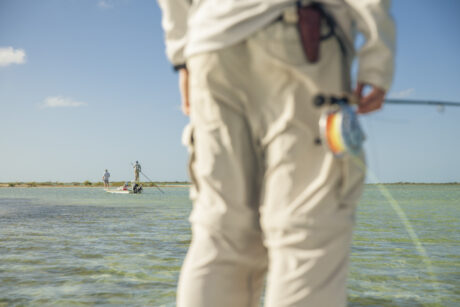
If you’ve ever gone bonefishing at Andros South Lodge or any other place in The Bahamas, you’ve probably heard the phrase extolled by your enthusiastic Bahamian Guide.
When you trout set, your fly rod can be used as a shock absorber by being raised; it provides a smooth, consistent pull on the fly that shields a light trout tippet and effectively and efficiently pins your barbless hook into the lip of a trout. When it comes to bonefish, the hook must be buried quickly and sharply to stick the fish because bonefish have hard lips. You want your fly to be pierced in the lip, but if you raise the tip of your rod, it will be dragged straight out of the fish’s mouth. So, how do I set the hook whilst bonefishing? What kind of set do you do?
The strip set is beyond a method; it’s the coded handshake of bonefishing, a juncture that distinguishes the experienced fishermen from the enthusiastic beginners. Consider a bonefish, slick and crafty, swimming through the shallows, and rather than lifting your rod as you would for trout, which is as pointless as trying to catch smoke with your bare hands, you strip your line with a smooth, fluid, and intentional motion. This technique ensures that when the fish inhales your fly by simulating the enticing escape of prey, you’re prepared to give a hard hook set instead of jerking it back into the phantom zone. Achieving proficiency in this technique turns your fishing experience from pure luck to deft artistry; it’s about building a relationship with the fish that involves just as much skill as finesse.


Here is an exercise to help you understand the difference between a trout set and a strip set.
- String up a fly rod with a line and leader but with no fly.
- Grab onto the end of the leader (with a light leader; you can wrap it around your hand if you like).
- Have your buddy grab the fly rod and step back about 20 feet.
- Then have him (or her) do a trout set i.e. just briskly raise the rod tip. Pretty smooth pull, huh?
- Now have your buddy point the rod straight at you, slowly pull in the excess line, and after the line is tight, give it another quick strip. Okay, the point made?
If you can’t pull this off, just trust us; the classic trout set results in a very smooth, gradual pull, excellent for protecting 7x tippets for trout but is terrible for burying #2 saltwater hooks into the mouth of a bonefish (a.k.a. the flats shrimp and crab excavator). Stripping the fly with the rod pointed straight at the fish will result in a much sharper, more powerful, and effective jab. Here is a step-by-step on how to present and then set the hook when a bonefish eats:
- Make your cast.
- Keep your rod tip in the water, pointed straight at the fish. Strip out any excess slack.
- When the fish sees the fly, give it a few quick strips.
- Once the fish starts following, keep moving the fly, pausing only to let the fish keep up with it.
- Keep your rod pointed straight at the fish.
- When you see the fish tip down to eat, or you feel resistance when stripping the fly line, keep your rod pinned straight at the fish.
- Now, give the line one more firm, long strip. You’ll notice your line will stop dead, or the fish will take off, but in either case, the hook is now set, and you can raise the rod tip and have some fun fighting that bonefish.
We get it. Habits die hard. It is tough not to raise your fly rod. The best way to remember is to just keep stripping until the line gets tight. If you do that and you don’t raise your rod tip, chances are you’ve buried the hook into that fish’s mouth, and you’re good to go!

Leave a Reply